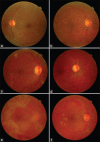The Muranga Teleophthalmology Study: A Comparison of Virtual (Teleretina) Assessment with in-person Clinical Examination to Diagnose Diabetic Retinopathy and Age-related Macular Degeneration in Kenya
- PMID: 32874041
- PMCID: PMC7442076
- DOI: 10.4103/meajo.MEAJO_144_19
The Muranga Teleophthalmology Study: A Comparison of Virtual (Teleretina) Assessment with in-person Clinical Examination to Diagnose Diabetic Retinopathy and Age-related Macular Degeneration in Kenya
Abstract
Purpose: This study compares a web-based teleophthalmology assessment with a clinical slit lamp examination to screen for diabetic retinopathy (DR) and age-related macular degeneration (AMD) among diabetic patients in a rural East African district.
Methods: Six hundred and twelve eyes from 306 diabetic patients underwent both a clinical slit lamp examination and a teleretina (TR) assessment by an experienced ophthalmologist. Both assessments were compared for any DR and AMD using the early treatment diabetic retinopathy study and age-related eye disease study grading scales, respectively.
Results: Of the 612 TR assessment photos, 74 (12%) were deemed ungradable due to media opacities, poor patient cooperation, or unsatisfactory photographs. The ability to detect DR and AMD showed a fair agreement (kappa statistic 0.27 and 0.23, respectively) between the TR and clinical slit lamp examination. Relative to a clinical slit lamp evaluation, a positive TR diagnosis carried a 75.0% positive predictive value when diagnosing DR and a 27.3% positive predictive value when diagnosing AMD. A negative TR diagnosis carried a 97.2% negative predictive value for the diagnosis of DR and a 98.1% negative predictive value for the diagnosis of AMD.
Conclusion: When comparing TR assessments to clinical slit lamp examinations to diagnose DR and AMD, there was a fair agreement. Although further validation is needed, the TR approach provides a promising method to diagnose DR and AMD, two major causes of ocular impairment worldwide.
Keywords: Age-related macular degeneration; diabetic retinopathy; slit lamp examination; teleophthalmology; teleretina.
Copyright: © 2020 Middle East African Journal of Ophthalmology.
Conflict of interest statement
There are no conflicts of interest.
Figures


References
-
- Bourne RR, Stevens GA, White RA, Smith JL, Flaxman SR, Price H, et al. Causes of vision loss worldwide, 1990-2010: A systematic analysis. Lancet Glob Heal. 2013;1:e339–49. - PubMed
-
- Wong WL, Su X, Li X, Cheung CM, Klein R, Cheng CY, et al. Global prevalence of age-related macular degeneration and disease burden projection for 2020 and 2040: A systematic review and meta-analysis. Lancet Glob Heal. 2014;2:e106–16. - PubMed
-
- International Diabetes Federation. IDF Diabetes Atlas-2017 Atlas. Diabetes Atlas. 2017. [Last accessed on 2018 Jul 08]. p. 150. Available from: http://diabetesatlas.org/resources/2017-atlas.html .
Publication types
MeSH terms
LinkOut - more resources
Full Text Sources
Medical

